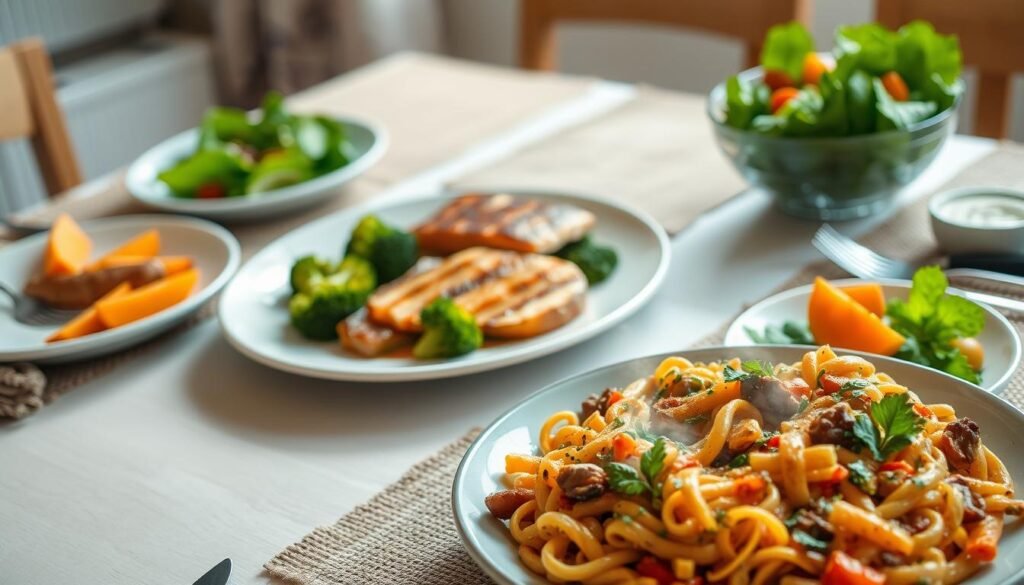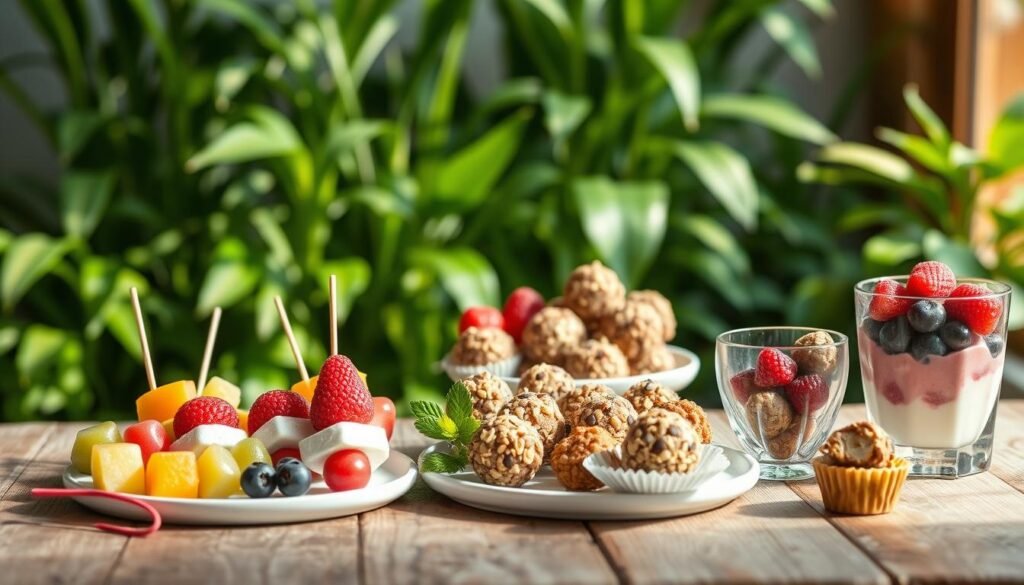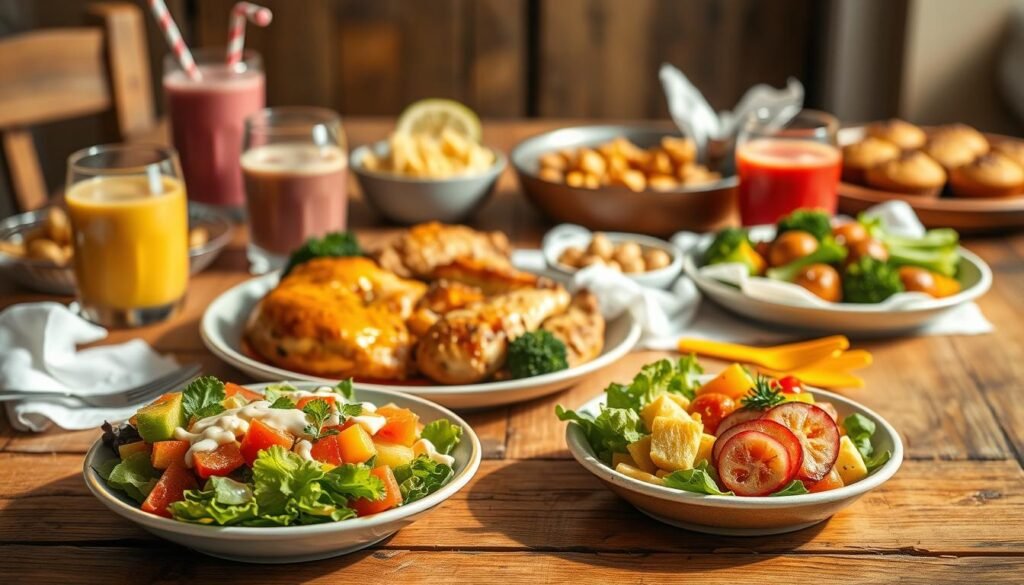Does getting nutritious meals on the table feel like a daily battle? You’re not alone. Parents across the U.S. juggle tight schedules and picky eaters, often sacrificing balance for convenience. But what if you could serve dishes that satisfy both your family’s taste buds and nutritional needs?
We’ve curated 10 family-approved meals designed by nutrition experts to cut kitchen stress. These options blend colorful ingredients kids love with hidden veggies and lean proteins. Think crispy sweet potato fries paired with turkey sliders or creamy avocado pasta with a veggie-packed sauce.
Best part? Each recipe takes under 30 minutes to prepare. No complicated steps or hard-to-find items—just simple, wholesome cooking that fits busy weeknights. You’ll even find clever swaps to boost fiber or reduce added sugars without sacrificing flavor.
Key Takeaways
- All recipes are nutritionist-approved for balanced meals
- Includes time-saving tips for faster meal prep
- Solutions for common picky eater challenges
- Uses affordable, easy-to-find ingredients
- Hidden veggie tricks to boost nutrition
- Clear dietary labels (gluten-free, dairy-free options)
Why Kid-Friendly Recipes Matter
Starting healthy habits at dinner time is key. Kid-friendly recipes do more than just feed them. They help with physical growth, cognitive development, and emotional connections with food. Meals that are both nutritious and fun help nourish both body and mind.
Benefits of Healthy Eating for Kids
Healthy meals do more than just give kids energy for play. Research shows they:
- Help kids focus better in school
- Boost their immune systems to fight off sickness
- Support strong bones and muscles with key vitamins
A 2023 CDC report found kids who eat well are 40% less likely to face obesity problems later.
Encouraging Good Eating Habits Early
Here are simple ways to make healthy meals a hit with picky eaters:
| Strategy | Impact | Example |
|---|---|---|
| Food Exploration | Expands palate diversity | Let kids choose one new veggie weekly |
| Colorful Plates | Boosts visual appeal | Rainbow fruit skewers with yogurt dip |
| Mini Portions | Reduces mealtime pressure | Bite-sized chicken & veggie bites |
Making Mealtimes Enjoyable
Make dinner fun with these ideas:
- Use cookie cutters to shape sandwiches into stars or animals
- Create DIY topping bars for tacos or baked potatoes
- Host monthly “Try It Tuesday” with one new ingredient
Laughter and a relaxed setting help kids see healthy food as fun.
Quick and Easy Breakfast Ideas
Mornings don’t have to be a rush to cereal or sweet pastries. These kid-approved healthy breakfast ideas are quick and nutritious. They’re packed with hidden veggies, whole grains, and protein to start the day right.

Fruit and Yogurt Parfaits
Make a breakfast masterpiece by layering Greek yogurt, fresh berries, and granola in clear cups. Kids can add their favorite toppings like bananas, chia seeds, or dark chocolate chips. “It’s like building a sweet treasure chest they can’t resist digging into,” says Texas mom and nutrition coach Lisa Marrero.
For kids who can’t have dairy, use dairy-free yogurt. Swap granola for toasted oats to cut down on sugar. Prep the ingredients the night before for a quick morning.
Veggie Omelet Muffins
Whisk eggs with shredded zucchini, diced bell peppers, and cheddar cheese, then bake in muffin tins. These protein-packed bites are good for three days in the fridge. Just microwave for 30 seconds. Pro tip: Blend spinach into the egg mixture for hidden greens.
Enjoy with whole-grain toast or apple slices for a balanced meal. Gluten-free families can use chickpea flour instead of regular flour.
Overnight Oats with Toppings
Combine rolled oats, milk, and chia seeds in jars, then soak overnight. In the morning, add colorful toppings like diced mango, toasted coconut, or almond butter. This quick and easy family meal gives slow energy to avoid mid-morning slumps.
For nut-free options, use sunflower seed butter instead of peanut butter. Warm the oats a bit if your child likes their breakfast hot.
Fun Lunch Ideas for School
Make midday meals exciting with lunchbox magic. These simple healthy recipes for children turn simple ingredients into fun meals. They keep kids’ energy up all day long. Here are three ways to make lunches a hit with kids.
Whole Grain Turkey Wraps
Use spinach tortillas or whole wheat lavash instead of regular bread. Add sliced turkey, shredded carrots, and mashed avocado for a tasty mix. Roll it up and slice into pinwheels for easy eating.
Pro tip: Use a toothpick with a cheese flag to keep wraps together. Serve with cucumber sticks and hummus for extra fiber.
DIY Lunchables with a Healthy Twist
Make your own snack boxes with:
- Whole grain crackers or pita chips
- Diced grilled chicken or turkey pepperoni
- Cheese cubes or calcium-rich yogurt dip
- Sliced strawberries or apple wedges
This lets kids pick their own nutritious meals for kids. Use silicone cupcake liners to keep things separate and prevent sogginess.
Colorful Veggie Bento Boxes
- Red: Cherry tomatoes or bell pepper strips
- Orange: Sweet potato fries or baby carrots
- Yellow: Corn kernels or roasted squash
- Green: Sugar snap peas or zucchini coins
Add a fun dip like beetroot yogurt or pumpkin seed butter. Change up the colors each week to introduce new tastes.
Delicious Dinner Recipes Everyone Will Enjoy
End dinner fights with these tasty, healthy meals. They’re perfect for picky eaters. These family-friendly healthy dinners make classic dishes healthier without losing flavor. You can sneak veggies into meatloaves or upgrade stuffed peppers with better proteins.

Baked Chicken Tenders with a Crunch
Choose oven-baked chicken tenders over deep-fried ones. Coat them in whole-grain panko or almond flour. Dip in Greek yogurt for more protein.
Kids love the crispy outside, while parents get 25g of lean protein. Pair with roasted sweet potato fries for a full meal.
Quinoa and Black Bean Stuffed Peppers
Turn bell peppers into bowls with quinoa, black beans, and low-fat cheese. This veggie dish has 12g of plant-based protein. Let kids pick their fillings for a fun twist.
Mini Turkey Meatloaves with Hidden Veggies
Make mini meatloaves in muffin tins with zucchini and carrots. Use lean turkey to cut fat by 40% compared to beef. Top with a tangy tomato glaze for a sweet touch.
| Recipe | Prep Time | Key Nutrients | Picky-Eater Win |
|---|---|---|---|
| Chicken Tenders | 25 mins | High protein, vitamin B6 | Familiar finger food |
| Stuffed Peppers | 35 mins | Fiber, vitamin C | Customizable fillings |
| Turkey Meatloaves | 40 mins | Iron, vitamin A | Fun mini portions |
These recipes show that wholesome meals can please everyone. By changing textures and making meals fun, you’ll get kids excited about dinner.
Healthy Snack Options for After School
After-school hunger needs snacks that keep minds sharp and bodies growing. These delicious and healthy snacks for kids are quick to make and packed with nutrients. They help keep energy up without ruining dinner. Plus, they’re easy for kids to help with!
Homemade Trail Mix
Don’t buy trail mix with too much sugar. Make your own with:
- Unsalted nuts (almonds, cashews)
- Seeds like pumpkin or sunflower
- Dried fruit without added sugars
- Dark chocolate chips (70% cacao)
Let kids pick their mix for reusable containers. This simple healthy recipe for children teaches them about portions. It also gives them protein and fiber.
Veggie Chips with Hummus
Make veggie chips into tasty snacks:
- Thinly slice sweet potatoes, zucchini, or kale
- Toss with olive oil and bake at 375°F until crisp
- Serve with protein-packed hummus for dipping
This snack is full of vitamins A and C. It also has plant-based protein to help with homework.
Frozen Yogurt Bark with Fruit
Beat the heat with this cool treat:
- Spread Greek yogurt on a parchment-lined tray
- Top with berries, banana slices, or mango chunks
- Freeze for 3 hours, then break into pieces
This snack is rich in calcium and antioxidants. It’s a delicious and healthy snack for kids that tastes like dessert. Use dairy-free yogurt for dietary needs.
Sweet Treats That Won’t Spoil Dinner
Craving something sweet doesn’t mean you have to give up on nutrition. With smart swaps and creative ways, you can make desserts that boost energy instead of causing a crash. These recipes use natural sweeteners like ripe bananas and honey. They also add fiber, healthy fats, and vitamins.

Banana Oatmeal Cookies
Mash two overripe bananas with rolled oats, cinnamon, and dark chocolate chips for a chewy cookie. It’s ready in just 15 minutes. No added sugar is needed—the bananas sweeten it naturally. Bake at 350°F until golden, and kids will want more!
| Nutrient | Per Serving | Key Benefit |
|---|---|---|
| Fiber | 3g | Supports digestion |
| Potassium | 220mg | Boosts muscle health |
| Vitamin B6 | 15% DV | Enhances brain function |
Healthy Chocolate Avocado Mousse
Blend avocado, cocoa powder, maple syrup, and vanilla extract for a creamy dessert. It’s rich in monounsaturated fats. Serve in mini cups with berry toppings. Even picky eaters won’t guess the secret veggie base!
Fruit Kabobs with Yogurt Dip
Thread strawberries, pineapple, and grapes onto skewers for a fun treat. Pair with a dip made from Greek yogurt, honey, and lime zest. This combo gives you vitamin C and probiotics while keeping portions small.
These desserts show you don’t need refined sugar to satisfy cravings. By using whole ingredients, you’ll make wholesome recipes for picky eaters that meet daily nutrition goals. Let kids customize toppings or shapes to make treats feel extra special!
How to Involve Kids in Cooking
Getting kids in the kitchen is more than just cooking meals. It’s about making memories together. When you make cooking a team effort, you boost confidence and teach important skills. Plus, making family-friendly healthy dinners becomes an exciting journey.
Begin with tasks that fit their age. Watch as their excitement grows as they help with quick and easy meals. Everyone will enjoy these family dinners.
Fun Cooking Activities for Kids
Make simple recipes fun. Young kids can decorate whole-grain tortilla pizzas with veggies. They can make faces with the toppings.
Older kids can measure for smoothies or put together rainbow salad jars. These activities make meal prep fun and introduce new tastes.
Teaching Kitchen Safety
Teaching safety is easy when kids help in the kitchen. Show them how to hold knives right (blade down!) and use oven mitts. Also, teach them to keep long hair tied back.
Make simple rules like “Always ask before touching the stove.” This helps them develop safe habits for life.
Simple Tasks for Little Hands
- Washing fruits/veggies in a colander
- Stirring batter or mixing dry ingredients
- Using cookie cutters on soft foods
- Placing toppings on casseroles or pizzas
Celebrate their help, even if it means cleaning up spills. When kids feel proud of their part in cooking, they’re more likely to try new foods. This helps them develop healthy eating habits.
Being Creative with Healthy Ingredients
Turning everyday meals into nutritious meals for kids doesn’t mean losing flavor or fun. A bit of creativity can transform simple ingredients into exciting dishes. These dishes will please both picky and adventurous eaters. Let’s explore three ways to make your family’s meals healthier and more fun.
Substituting for Healthier Options
Small changes can make a big difference. Here are some easy swaps:
- Use mashed avocado instead of mayo in sandwiches
- Replace half the flour in baked goods with oat or almond flour
- Swap sour cream for Greek yogurt in dips and dressings
For delicious and healthy snacks for kids, blend frozen bananas into “nice cream.” This is a healthier alternative to sugary ice cream. These changes add nutrients while keeping the taste familiar.
Exploring International Cuisines
Global flavors bring fresh ingredients and bold spices to the table. Here are some kid-friendly ideas:
- Mexican veggie fajitas with colorful bell peppers
- Japanese rice bowls with teriyaki-glazed tofu
- Mediterranean pita pockets with hummus and cucumber
Introduce new foods slowly by mixing them with favorites. For example, add shredded zucchini to taco meat for a nutrition boost!
Building Flavor with Herbs and Spices
Forget the salt shaker and try these flavor enhancers:
| Herb/Spice | Kid-Friendly Use | Nutrition Bonus |
|---|---|---|
| Cinnamon | Oatmeal or sweet potatoes | Supports blood sugar balance |
| Paprika | Roasted veggies or popcorn | Rich in antioxidants |
| Basil | Pasta sauces or fruit salads | Contains anti-inflammatory properties |
Let kids mix their own spice blends for roasted chickpeas or popcorn. This makes nutritious meals for kids feel like a fun art project!
Planning Meals with Kids in Mind
Make your family’s meals easier by involving kids in planning. This approach reduces stress and makes quick and easy family meals fun. When kids help choose meals, they’re more likely to eat them. You’ll also spend less time arguing at dinner.
Creating a Weekly Meal Plan
Begin with a flexible menu that includes simple healthy recipes for children. Let kids pick one or two meals each week. Think about taco nights or pasta dishes with lots of veggies. Here are three steps to make it easier:
- Choose theme days (e.g., Meatless Monday, Stir-Fry Friday)
- Batch-prep proteins and grains for multiple meals
- Leave one night open for leftovers or creative experiments
Shopping Together for Ingredients
Make grocery trips fun learning experiences. Create a colorful list with your kids. Focus on these nutrient-rich staples:
| Healthy Choices | Processed Alternatives |
|---|---|
| Fresh fruits | Sugary snacks |
| Whole grain bread | White bread |
| Greek yogurt | Flavored yogurt tubes |
Challenge older kids to compare nutrition labels. For younger children, make it a scavenger hunt for rainbow-colored produce.
Preparing for Busy Weeknights
Here are tips for keeping quick and easy family meals on track during busy evenings:
- Pre-chop vegetables on Sundays
- Freeze kid-friendly soups or casseroles
- Keep 15-minute recipes handy (e.g., quesadillas with hidden spinach)
Store pre-portioned smoothie packs or overnight oats for mornings when time is tight. These simple healthy recipes for children ensure nutrition is always a priority.
Exploring Dietary Preferences
Finding meals that fit dietary needs doesn’t mean losing flavor. You can make family-friendly healthy dinners that everyone will love. We’ll look at recipes and tips for different diets that are both tasty and healthy.

Kid-Friendly Gluten-Free Recipes
Gluten-free meals can be tasty with a few simple changes. Try using crushed gluten-free cornflakes for crispy chicken tenders. Serve them with sweet potato fries for a complete meal. For breakfast, make pancakes with oat flour and top with fresh berries for sweetness.
| Dietary Need | Easy Substitute | Kid-Approved Recipe |
|---|---|---|
| Gluten-Free | Almond flour or gluten-free oats | Cheesy cauliflower pizza crust |
| Nut-Free | Sunflower seed butter | Energy balls with oats & dried fruit |
| Vegan | Chickpea pasta | Rainbow veggie stir-fry |
Addressing Nut Allergies
Make meals safe and tasty with seed-based options. Use pumpkin seeds for “no-nut” pesto. For snacks, try apple slices with sunflower seed butter. Always check labels for hidden nuts in sauces and baked goods.
Vegetarian and Vegan Options
Make plant-based meals fun with flavors kids enjoy. Try lentil tacos with mild spices. Blend tofu into smoothies for protein, or make pasta sauce with zucchini and carrots. Let kids help with colorful grain bowls.
- Swap dairy cheese for nutritional yeast in mac & cheese
- Use mashed bananas as egg substitutes in baked goods
- Try meatless burger patties made with black beans
Tips for Picky Eaters
If your child doesn’t like greens, these tips can help. Start with nutritious meals for kids and delicious and healthy snacks for kids. This way, you’ll make eating fun and exciting.
Sneaking in Nutrients
Blend veggies into sauces or smoothies for a secret nutrition boost. Here are some ideas:
- Mix cauliflower into mashed potatoes
- Add spinach to blueberry smoothies
- Use whole-grain flour in pancake batter
| Ingredient | Nutrient Boost | Best For |
|---|---|---|
| Chia seeds | Omega-3s & fiber | Yogurt or oatmeal |
| Zucchini | Vitamin C & potassium | Muffins or pasta sauce |
| Lentils | Plant-based protein | Taco meat or soups |
Making Food Visually Appealing
How food looks is very important. Chef Annabel Karmel says:
“A rainbow plate isn’t just pretty – it’s a nutritional powerhouse waiting to be explored.”
Here are some ways to make food look great:
- Arrange fruits in smiley-face patterns
- Use star-shaped cookie cutters for sandwiches
- Layer colorful veggies in clear containers
Tasting Parties to Expand Palates
Make tasting food a fun game with these steps:
| Traditional Approach | Tasting Party Method | Success Rate |
|---|---|---|
| Forced bites | Small samples on lollipop sticks | +40% acceptance |
| Single new food | 3-5 options with fun names | +65% engagement |
Make tasting fun by praising any effort. Even a sniff or lick is a step forward!
Encouraging Family Mealtime Togetherness
Gathering at the table is more than just eating. It’s about making memories and strengthening bonds. Whether it’s a quick weeknight meal or a big weekend dinner, being together is key. It helps create lasting memories and closer relationships.
Try serving quick and easy family meals or weekend feasts. This way, you make sure everyone is together and enjoying each other’s company.
Benefits of Family Meals
Family dinners are great for talking and feeling good. Kids who eat with their families tend to do better in school and eat healthier. It’s also a chance to show them how to make good food choices in a relaxed way.
Making It a Fun Routine
Make mealtime something everyone looks forward to. Here are a few ideas:
- Theme nights: Try Taco Tuesdays or Breakfast-for-Dinner Fridays for fun.
- Conversation starters: Ask things like “What made you smile today?”
- No-tech zones: Keep phones and tablets away to talk more.
Ideas for Family Cooking Nights
Make meal prep a team effort. Let everyone help, like washing veggies or making wraps. Here are some fun activities to try together:
| Activity | Skills Learned | Recommended Dish |
|---|---|---|
| DIY Pizza Station | Creativity, knife safety | Whole-wheat veggie pizzas |
| Build-Your-Own Bowl | Portion control, flavor pairing | Quinoa grain bowls |
| Cookie Decorating | Fine motor skills | Oatmeal raisin cookies |
Keep recipes simple to focus on having fun. Try making stuffed peppers or sheet-pan fajitas together. End the night by celebrating your teamwork, even if things don’t turn out perfectly!
Addressing Nutritional Concerns and Myths
Online, there’s a lot of conflicting advice. It’s easy to get confused about what’s best for nutritious meals for kids. Let’s look at the facts and focus on science-backed ways to feed your child.
Clarifying Common Misconceptions
Many think “healthy food is bland.” But, wholesome recipes for picky eaters can be full of flavor. Use herbs, spices, or creative ways to present food. Another myth is “kids need to clean their plates.” Forcing them can make them dislike food. Instead, let them decide when they’re full.
What Makes a Balanced Meal
A balanced meal for kids has four main parts, says Mayo Clinic guidelines:
| Food Group | Role | Kid-Friendly Examples |
|---|---|---|
| Proteins | Builds muscles | Grilled chicken, scrambled eggs |
| Whole Grains | Provides energy | Quinoa, whole-wheat pasta |
| Fruits/Veggies | Supports immunity | Berries, roasted sweet potatoes |
| Dairy/Alternatives | Strengthens bones | Yogurt, fortified almond milk |
Nutrients Essential for Growing Kids
Focus on these five nutrients for growth:
- Protein: Helps repair tissues (try lean meats or lentils)
- Calcium: Crucial for bone health (dairy or leafy greens)
- Iron: Boosts brain function (red meat or fortified cereals)
- Vitamin C: Enhances iron absorption (citrus fruits or bell peppers)
- Omega-3s: Supports focus (salmon or chia seeds)
Remember, variety is key. Try different ingredients in wholesome recipes for picky eaters. This way, kids can try new flavors without feeling forced.
Resources for Further Exploration
Building healthy eating habits takes ongoing support and inspiration. These trusted tools make meal planning easier and keep kids excited about healthy foods. Check out cookbooks, blogs, and communities for simple, tasty recipes for kids.
Cookbooks for Every Family’s Needs
America’s Test Kitchen has The Complete Baby and Toddler Cookbook with 150 recipes for different ages. For tasty breakfast ideas, try Catherine McCord’s Weelicious Lunches. It has make-ahead options for busy mornings.
Digital Inspiration at Your Fingertips
Websites like Super Healthy Kids and Yummy Toddler Food offer free meal plans and shopping lists. The Cookie Rookie’s “30 Minute Meals” section has quick, kid-friendly dinner ideas.
Communities for Shared Success
Facebook groups like “Healthy Family Meals” and Reddit’s r/EatCheapAndHealthy share lunchbox tips and allergy-friendly swaps. Local parenting groups often host cooking classes for families.
Save these resources for your next grocery trip or to try new recipes. Many platforms have seasonal guides and video tutorials. They help kids learn to cook and try new flavors.
FAQ
How can I make healthy meals appealing to picky eaters?
Try creative presentations like bento boxes or colorful veggie arrangements. Hide nutrients in familiar favorites – blend spinach into smoothies or mix grated zucchini into turkey meatloaf. Involve kids in meal prep to increase their interest in trying new foods.
What are quick breakfast ideas for busy school mornings?
Prepare overnight oats with chia seeds and berries the night before, or bake veggie-packed egg muffins on Sundays. Greek yogurt parfaits with granola and fruit take under 5 minutes to assemble and provide protein for sustained energy.
How do I upgrade school lunches beyond basic sandwiches?
Create DIY lunch kits with whole-grain crackers, nitrate-free turkey slices, and cheese cubes. Use cookie cutters to shape watermelon stars or cucumber flowers. Pack hummus with rainbow veggie sticks for crunch and nutrition.
Can healthy snacks actually satisfy my child’s hunger after school?
Absolutely! Pair apple slices with almond butter for fiber and protein, or make homemade trail mix with pumpkin seeds and dark chocolate chips. Frozen banana “ice cream” with cocoa powder provides a sweet treat with potassium and antioxidants.
How do I handle dessert requests without compromising nutrition?
Offer naturally sweet options like dates stuffed with peanut butter or yogurt-dipped strawberry skewers. Blend frozen bananas with avocado for creamy chocolate mousse that delivers healthy fats and vitamins.
What kitchen tasks are safe for young children?
Preschoolers can wash produce, tear lettuce, or stir batter. School-age kids can measure ingredients, use cookie cutters, or assemble wraps. Always supervise knife use and teach proper handling of hot surfaces.
How can I adapt recipes for food allergies?
Substitute sunflower seed butter in place of peanut butter, or use gluten-free oat flour in baked goods. For dairy restrictions, try coconut yogurt or cashew-based cheeses in recipes like stuffed peppers or veggie pizzas.
What’s the best way to introduce new vegetables?
Host weekly “tasting parties” with small samples of roasted Brussels sprouts or air-fryer zucchini chips. Pair new veggies with familiar dips like ranch or guacamole. Gradually increase portions as their acceptance grows.
How do I create balanced meals quickly on weeknights?
Use the 50/25/25 plate method: half veggies/fruits, quarter lean protein (like baked chicken tenders), quarter whole grains (quinoa or brown rice). Batch-cook components like grilled chicken or roasted sweet potatoes for easy assembly.
Where can I find reliable kid-friendly recipe resources?
Check Weelicious for creative lunch ideas or Super Healthy Kids for balanced meal plans. The cookbook *”The Sneaky Chef”* offers clever nutrient-boosting strategies, while Kids Eat in Color provides science-backed picky eating solutions.

